英语语法_名词与冠词模板.
初中英语语法知识名词与冠词
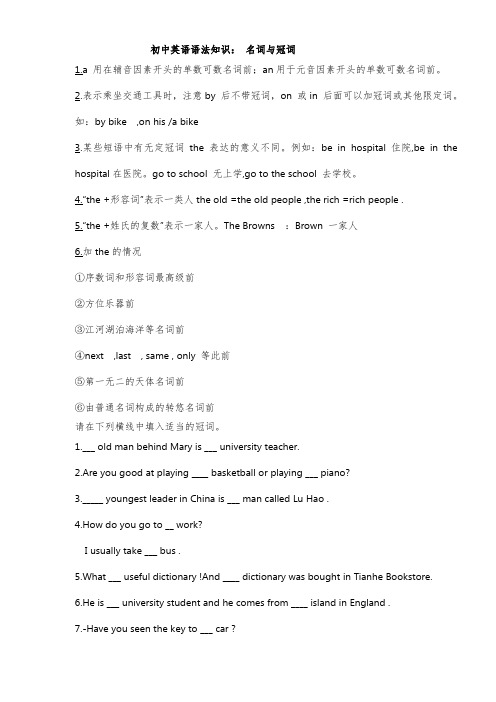
初中英语语法知识:名词与冠词1.a 用在辅音因素开头的单数可数名词前;an用于元音因素开头的单数可数名词前。
2.表示乘坐交通工具时,注意by 后不带冠词,on 或in 后面可以加冠词或其他限定词。
如:by bike ,on his /a bike3.某些短语中有无定冠词the表达的意义不同。
例如:be in hospital 住院,be in the hospital在医院。
go to school 无上学,go to the school 去学校。
4.“the +形容词”表示一类人the old =the old people ,the rich =rich people .5.“the +姓氏的复数”表示一家人。
The Browns :Brown 一家人6.加the的情况①序数词和形容词最高级前②方位乐器前③江河湖泊海洋等名词前④next ,last , same , only 等此前⑤第一无二的天体名词前⑥由普通名词构成的转悠名词前请在下列横线中填入适当的冠词。
1.___ old man behind Mary is ___ university teacher.2.Are you good at playing ____ basketball or playing ___ piano?3._____ youngest leader in China is ___ man called Lu Hao .4.How do you go to __ work?I usually take ___ bus .5.What ___ useful dictionary !And ____ dictionary was bought in Tianhe Bookstore.6.He is ___ university student and he comes from ____ island in England .7.-Have you seen the key to ___ car ?-I think ___ key is on the desk .8.-How far is it from our school to ___ seaside? -It is ___ eight – kilometer walk from here .9.I have got ___ bad headache all day ,so I think I’ll go to bed early .10.If you go by ___ train ,you can have quite a comfortable trip ,but make sure you get __ fast one .11.She has been in ___hospital for three days .We go to ___ hospital to see her every day .12.There is ____ book on the shelf .Would you please get ___book for me ?13.Learning ____ country’s language is a better way of knowing ____culture behind it .14.I hope we can fly to ___moon one day .7.数词加名词作定语时,有两种表达。
英语语法(名词和冠词)
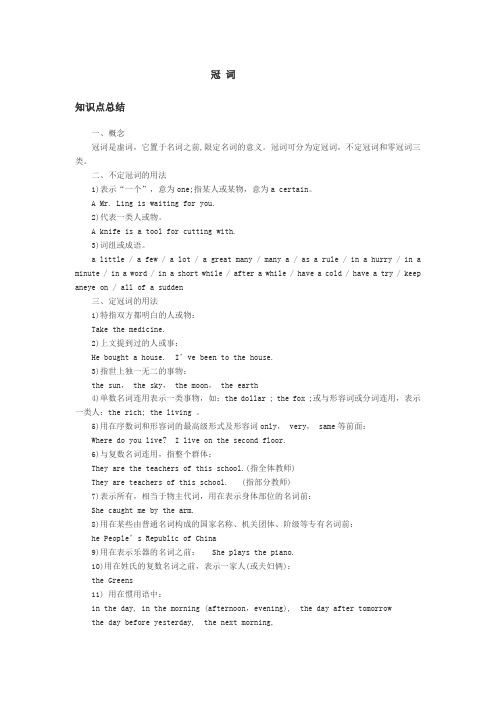
冠词知识点总结一、概念冠词是虚词,它置于名词之前,限定名词的意义。
冠词可分为定冠词,不定冠词和零冠词三类。
二、不定冠词的用法1)表示“一个”,意为one;指某人或某物,意为a certain。
A Mr. Ling is waiting for you.2)代表一类人或物。
A knife is a tool for cutting with.3)词组或成语。
a little / a few / a lot / a great many / many a / as a rule / in a hurry / in a minute / in a word / in a short while / after a while / have a cold / have a try / keep aneye on / all of a sudden三、定冠词的用法1)特指双方都明白的人或物:Take the medicine.2)上文提到过的人或事:He bought a house. I’ve been to the house.3)指世上独一无二的事物:the sun, the sky, the moon, the earth4)单数名词连用表示一类事物,如:the dollar ; the fox ;或与形容词或分词连用,表示一类人:the rich; the living 。
5)用在序数词和形容词的最高级形式及形容词only, very, same等前面:Where do you live? I live on the second floor.6)与复数名词连用,指整个群体:They are the teachers of this school.(指全体教师)They are teachers of this school. (指部分教师)7)表示所有,相当于物主代词,用在表示身体部位的名词前:She caught me by the arm.8)用在某些由普通名词构成的国家名称、机关团体、阶级等专有名词前:he People’s Republic of China9)用在表示乐器的名词之前: She plays the piano.10)用在姓氏的复数名词之前,表示一家人(或夫妇俩):the Greens11) 用在惯用语中:in the day, in the morning (afternoon,evening), the day after tomorrowthe day before yesterday, the next morning,in the sky (water,field,country)in the dark, in the rain, in the distance,in the middle (of), in the end,on the whole, by the way, go to the theatre四、零冠词的用法1)国名,人名前通常不用定冠词:England,Mary;2)泛指的复数名词,表示一类人或事物时,可不用定冠词;They are teachers.3)抽象名词表示一般概念时,通常不加冠词;Failure is the mother of success.4)物质名词表示一般概念时,通常不加冠词,当表示特定的意思时,需要加定冠词;Man cannot live without water.5)在季节、月份、节日、假日、日期、星期等表示时间的名词之前,不加冠词;We go to school from Monday to Friday.6)在称呼或表示官衔,职位的名词前不加冠词;The guards took the American to General Lee.7)在三餐、球类运动和娱乐运动的名称前,不加冠词如:have breakfast,play chess8)当两个或两个以上名词并用时,常省去冠词;I can’t write without pen or pencil.9)当by 与火车等交通工具连用,表示一种方式时,中间无冠词;如:by bus,by train;10)有些个体名词不用冠词;如:school,college,prison,market,hospital,bed,table,class,town, church,court 等个体名词,直接置于介词后,表示该名词的深层含义;go to hospital11)不用冠词的序数词;a. 序数词前有物主代词That’s his thirtieth birthday.b. 序数词作副词 He came first in the race.c. 在固定词组中 at (the) first, first of all, from first to last常见考法1.名词前不定冠词的用法;2.不用冠词的特殊情况;3对冠词与主谓一致的考查;4.定冠词与形容词、分词连用表一类人;5.冠词与姓氏的连用;6.有无冠词的意义及区别;7.冠词与such, so how, what等词的位置关系。
2.名词所有格+冠词
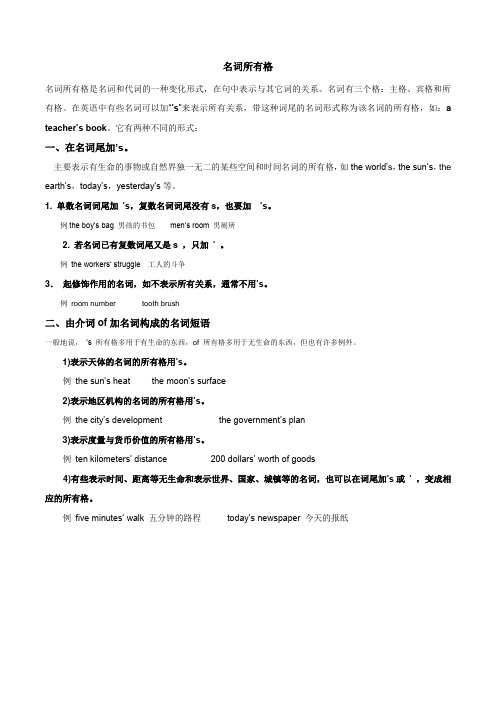
名词所有格名词所有格是名词和代词的一种变化形式,在句中表示与其它词的关系。
名词有三个格:主格、宾格和所有格。
在英语中有些名词可以加“’s”来表示所有关系,带这种词尾的名词形式称为该名词的所有格,如:a teacher’s book。
它有两种不同的形式:一、在名词尾加’s。
主要表示有生命的事物或自然界独一无二的某些空间和时间名词的所有格,如the world’s,the sun’s,the earth’s,today’s,yesterday’s等。
1. 单数名词词尾加’s,复数名词词尾没有s,也要加’s。
例the boy’s bag 男孩的书包men’s room 男厕所2. 若名词已有复数词尾又是s ,只加’。
例the workers’ struggle工人的斗争3.起修饰作用的名词,如不表示所有关系,通常不用’s。
例room number tooth brush二、由介词of加名词构成的名词短语一般地说,’s 所有格多用于有生命的东西,of 所有格多用于无生命的东西,但也有许多例外。
1)表示天体的名词的所有格用’s。
例the sun’s heat the moon’s surface2)表示地区机构的名词的所有格用’s。
例the city’s developmentthe government’s plan3)表示度量与货币价值的所有格用’s。
例ten kilometers’ distance200 dollars’ worth of goods4)有些表示时间、距离等无生命和表示世界、国家、城镇等的名词,也可以在词尾加’s或’ ,变成相应的所有格。
例five minutes’ walk 五分钟的路程today’s newspaper 今天的报纸1.---Excuse me,where are _______ offices?---Over there.A.teacher’s B.teachers’C.the teacher’s D.the teachers’2.Today is Septemb er 10th. It’s_____ Day. Let’s go and buy some flowers for our teachers.A. TeacherB. Teachers’C. the Teachers’D. Teacher’s3. This year, the most popular ________ hat is that kind.A. woman'sB. womens'C. women'sD. womans'4. This year, ________ is on May 9th.A.My mother's brithdayB. My mothers' brithdayC. My mothersbrithdayD. My mothers'sbrithday5. This is ________ , and I borrowed it two days ago.A.a picture of Mr. CoxB. a picture of Mr. Cox'sC. a Mr. Cox' pictureD. Mr. Cox's picture6. These are ________ .A.newspaper of todayB.today's newspaperC. today's newspapers'D. today newspaper's7. It's about ________ from my home to our school.A. twenty minutes' walkB. walk of twenty minutes'C. walk of twenty minutes'D. twenty minute's walk8. It's June 1st, it's ________ Day.A. ChildrensB. Children'sC. Childrens'D. Childrens's9. Oh dear, I forgot the two ______.A. room's mumberB.rooms' numberC.room numbersD.rooms' numbers10.This is my dress. That one is ____.A. MaryB. Mary’sC. MarysD. of Mary大卫的叔叔我妹妹的铅笔双胞胎的房间儿童节妇女节这本书的名字textmonkeybedtoyChineseradio box deerlife tooth leaf potatoclass people library zooorange tree woman doctor1. There are four and two in the group.A. Englishmen, GermenB.Englishman, GermenC. Englishmen,GermansD. Englishman, Germans2. In Britain _____ are all painted red.A. letter boxesB.letters boxesC. letter boxD.letters box冠词a 和an 的区别a用在辅音音素前,包括以前元音[j]、[w]开首的词前。
英语语法_谢孟媛
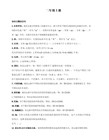
专有名词=>Bob,Smith,April,London...等。开头要大写,不能加冠词a/an。
*下列专有名词需要加上定冠词the。
(例)the United States.(美国)
4.冠词
冠词可分为不定冠词a/an 及 定冠词the,它通常放名词前,用来修饰名词。
a/an的用法 => a+子音开头的单数名词
an+母音开头的单数名词
(例)a book;a girl;a young man
an apple;an umbrella(伞);an old woman
c.一般动词字尾为子音+y时,需去y加ies。
(例)cry->cries, study->studies
*have和has=>have(有,吃)的单数动词为has。当第三人称单数时,have要变成has。
(例)They have a lot of money.
He has a lot of money.
(例)The girl is a junior high school student. //这个女孩是国中生。senior high school高中生
Is the girl a junior high school student? //这个女孩是国中生吗?
be动词开头的疑问句,可用Yes或No回答。
疑问句:Do/Does + 主词 + 原形动词 + ...?
(例)You visit your grandmother on Sundays. //你每逢星期天都去探望外婆。
高中英语语法讲解一 冠词和名词
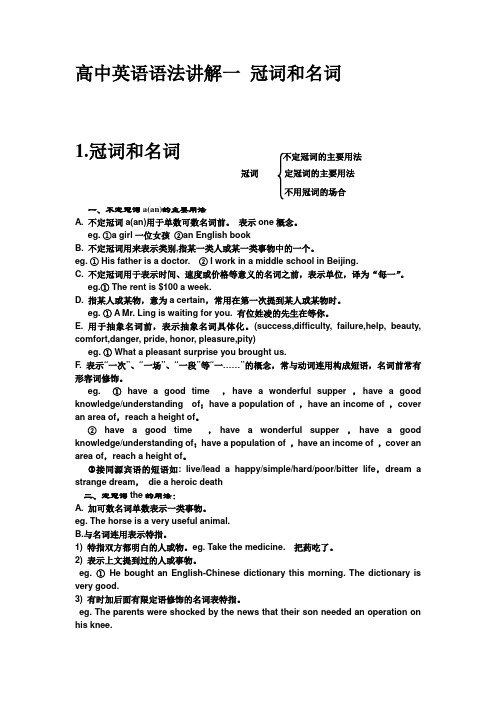
高中英语语法讲解一 冠词和名词1.冠词和名词一、不定冠词a(an)的主要用法A. 不定冠词a(an)用于单数可数名词前。
表示one 概念。
eg. ①a girl 一位女孩 ②an English bookB. 不定冠词用来表示类别,指某一类人或某一类事物中的一个。
eg. ① His father is a doctor. ② I work in a middle school in Beijing.C. 不定冠词用于表示时间、速度或价格等意义的名词之前,表示单位,译为“每一”。
eg.① The rent is $100 a week.D. 指某人或某物,意为a certain ,常用在第一次提到某人或某物时。
eg. ① A Mr. Ling is waiting for you. 有位姓凌的先生在等你。
E. 用于抽象名词前,表示抽象名词具体化。
(success,difficulty, failure,help, beauty, comfort,danger, pride, honor, pleasure,pity)eg. ① What a pleasant surprise you brought us. F. 表示“一次”、“一场”、“一段”等“一……”的概念,常与动词连用构成短语,名词前常有形容词修饰。
eg. ① have a good time ,have a wonderful supper ,have a good knowledge/understanding of ;have a population of ,have an income of ,cover an area of ,reach a height of 。
② have a good time ,have a wonderful supper ,have a good knowledge/understanding of ;have a population of ,have an income of ,cover an area of ,reach a height of 。
中考英语专题复习总结——冠词与名词
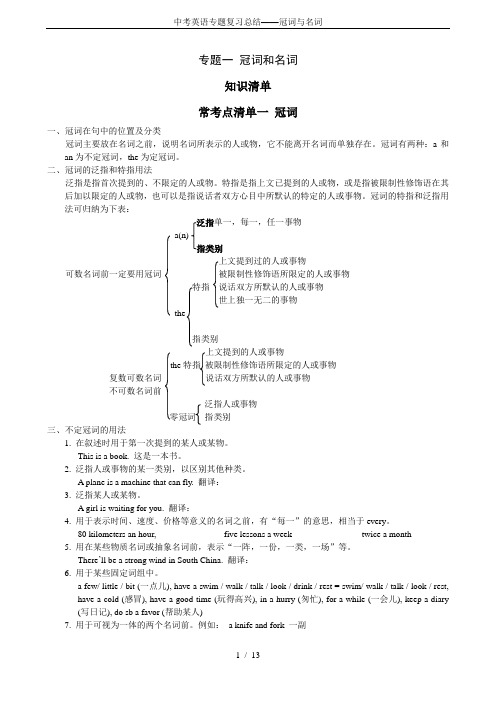
专题一冠词和名词知识清单常考点清单一冠词一、冠词在句中的位置及分类冠词主要放在名词之前,说明名词所表示的人或物,它不能离开名词而单独存在。
冠词有两种:a和an为不定冠词,the为定冠词。
二、冠词的泛指和特指用法泛指是指首次提到的、不限定的人或物。
特指是指上文已提到的人或物,或是指被限制性修饰语在其后加以限定的人或物,也可以是指说话者双方心目中所默认的特定的人或事物。
冠词的特指和泛指用法可归纳为下表:单一,每一,任一事物a(n)上文提到过的人或事物可数名词前一定要用冠词被限制性修饰语所限定的人或事物特指说话双方所默认的人或事物世上独一无二的事物the指类别the特指被限制性修饰语所限定的人或事物复数可数名词说话双方所默认的人或事物不可数名词前泛指人或事物零冠词指类别三、不定冠词的用法1. 在叙述时用于第一次提到的某人或某物。
This is a book. 这是一本书。
2. 泛指人或事物的某一类别,以区别其他种类。
A plane is a machine that can fly. 翻译:___3. 泛指某人或某物。
A girl is waiting for you. 翻译:___4. 用于表示时间、速度、价格等意义的名词之前,有“每一”的意思,相当于every。
80 kilometers an hour,_______________ five lessons a week _______________ twice a month____5. 用在某些物质名词或抽象名词前,表示“一阵,一份,一类,一场”等。
There’ll be a strong wind in South China. 翻译:___6. 用于某些固定词组中。
a few/ little / bit (一点儿), have a swim / walk / talk / look / drink / rest = swim/ walk / talk / look / rest,have a cold (感冒), have a good time (玩得高兴), in a hurry (匆忙), for a while (一会儿), keep a diary (写日记), do sb a favor (帮助某人)7. 用于可视为一体的两个名词前。
英语语法总结-冠词和名词
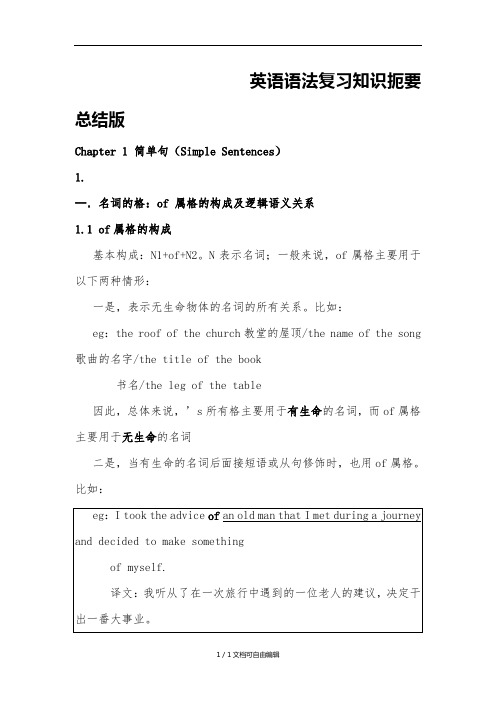
英语语法复习知识扼要总结版Chapter 1 简单句(Simple Sentences)1.一.名词的格:of 属格的构成及逻辑语义关系1.1 of属格的构成基本构成:N1+of+N2。
N表示名词;一般来说,of属格主要用于以下两种情形:一是,表示无生命物体的名词的所有关系。
比如:eg:the roof of the church教堂的屋顶/the name of the song 歌曲的名字/the title of the book书名/the leg of the table因此,总体来说,’s所有格主要用于有生命的名词,而of属格主要用于无生命的名词二是,当有生命的名词后面接短语或从句修饰时,也用of属格。
比如:1.2of属格的逻辑语义关系介词of可以表示很多种逻辑语义关系,读者最熟悉的应该是它表示的“所有关系”,译成“......的”。
比如:eg:The mother of the boy in a red suit is president of our company.穿红色西服的那个男孩的妈妈是我们公司的总经理。
除此以外,of还可以表示其他语义关系,共计十余种,这里只讨论三种:主谓关系、动宾关系和同位关系。
A.主谓关系:从右往左翻译基本结构:N1+of+N2。
N表示名词;一般来说,这里N1是由不及物动词变化过来的名词,表示某个行为,这一行为是由N2来发出的。
或者说N2是N1行为的执行者。
比如:eg:the arrival of my mother【点睛】:这里第一个名词arrival是由不及物动词arrive变化过来的,它表示一个行为;而第二个名词my mother则是这个行为的执行者,即相当于说my mother arrived.译文:我妈妈到了eg:the rise of the U.S. Superpower超级大国美国的兴起/thegrowth of agriculture农业增长B.动宾关系:从左往右翻译基本结构:N1+of+N2。
高中英语语法名词__冠词__代词
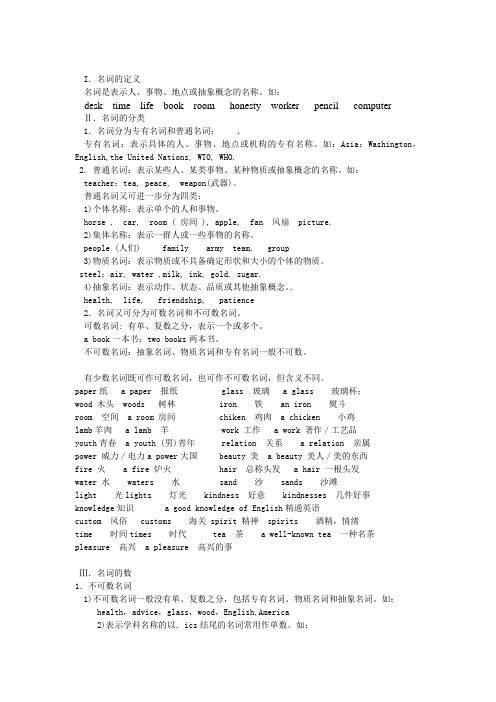
I.名词的定义名词是表示人、事物、地点或抽象概念的名称。
如:desk time life book room honesty worker pencil computer Ⅱ.名词的分类1.名词分为专有名词和普通名词:.专有名词:表示具体的人、事物、地点或机构的专有名称。
如:Asia;Washington,English,the United Nations, WTO, WHO.2. 普通名词:表示某些人、某类事物、某种物质或抽象概念的名称。
如:teacher;tea, peace, weapon(武器)。
普通名词又可进一步分为四类:1)个体名称:表示单个的人和事物。
horse , car, room ( 房间 ), apple, fan 风扇 picture.2)集体名称:表示一群人或一些事物的名称。
people (人们) family army team, group3)物质名词:表示物质或不具备确定形状和大小的个体的物质。
steel;air, water ,milk, ink, gold, sugar.4)抽象名词:表示动作、状态、品质或其他抽象概念。
.health, life, friendship, patience2.名词又可分为可数名词和不可数名词。
可数名词: 有单、复数之分,表示一个或多个。
a book一本书;two books两本书。
不可数名词:抽象名词、物质名词和专有名词一般不可数。
有少数名词既可作可数名词,也可作不可数名词,但含义不同。
paper纸 a paper 报纸 glass 玻璃 a glass 玻璃杯;wood 木头 woods 树林 iron 铁 an iron 熨斗room 空间 a room 房间 chiken 鸡肉 a chicken 小鸡lamb羊肉 a lamb 羊 work 工作 a work 著作/工艺品youth青春 a youth (男)青年 relation 关系 a relation 亲属power 威力/电力a power大国 beauty 美 a beauty 美人/美的东西fire 火 a fire 炉火 hair 总称头发 a hair 一根头发water 水 waters 水 sand 沙 sands 沙滩light 光lights 灯光 kindness 好意 kindnesses 几件好事knowledge知识 a good knowledge of English精通英语custom 风俗 customs 海关 spirit 精神 spirits 酒精,情绪time 时间times 时代 tea 茶 a well-known tea 一种名茶pleasure 高兴 a pleasure 高兴的事Ⅲ.名词的数1.不可数名词1)不可数名词一般没有单、复数之分,包括专有名词、物质名词和抽象名词。
- 1、下载文档前请自行甄别文档内容的完整性,平台不提供额外的编辑、内容补充、找答案等附加服务。
- 2、"仅部分预览"的文档,不可在线预览部分如存在完整性等问题,可反馈申请退款(可完整预览的文档不适用该条件!)。
- 3、如文档侵犯您的权益,请联系客服反馈,我们会尽快为您处理(人工客服工作时间:9:00-18:30)。
英语语法——名词与冠词来源:普特英语名词一.定义什么是名词表示人、事物、地点或抽象概念的名称的词,叫做名词。
如:baby 婴儿 time 时间pencil 铅笔 socialism 社会主义air 空气 Shanghai二.名词的种类英语名词可分为两大类:1.普通名词(common noun)普通名词是某一类人、某一类事物、某种物质或抽象概念的名称。
如:soldier 士兵 water 水pupil 学生 health 健康machine 机器 pleasure 快乐2.专有名词(proper noun)专有名词是个别的人、团体、地方、机构或事物的名称。
其中实词的第一个字母必须大写。
如:Lei Feng 雷锋 Karl Marx 卡尔•马克思London 伦敦 China 中国The Communist Party of China中国共产党The Great Hall of the People人民大会堂The Ministry of Foreign Affairs外交部1.1普通名词的种类普通名词可进一步分为:1)类名词(class noun)类名词表示人或事物属于某一类。
如:tractor 拖拉机 panda 熊猫factory 工厂 teacher 教员2)集体名词(collective noun)集体名词是一些人或物的总称。
如:class 阶级,班 herd 兽群crowd 人群 army 军队3)物质名词(material noun)物质名词表示物质或不具备确定形状和大小的个体的实物。
如:steel 钢 gram 粮食fire 火 cotton 棉花4)抽象名词(abstract noun)抽象名词表示动作、状态、品质或其他抽象概念。
如:happiness 幸福 life 生活work 工作 whiteness 白色三.名词的数名词又可分为可数名词(countable noun)与不可数名词(uncountable noun)。
可数名词有单、复数之分,不可数名词一般不分单数和复数。
类名词和集体名词一般是可数的;抽象名词、物质名词和专有名词一般是不可数的。
有少数名词既可用作不可数名词,又可用作可数名词,但意义有所不同。
如:用作不可数名词用作可数名词glass 玻璃玻璃杯paper 纸报纸,文件tin 锡罐头copper 铜铜币四.有关英语名词格的概述格(case)是名词或代词具有的形式及其变化,表示与其它词的关系。
英语的名词有三个格:主格(nominative case)、宾语(objective case)和所有格(possessive case)。
但英语的名词除所有格有形式的变化外,主格和宾格都没有形式变化。
名词在句中是主格或是宾格,主要通过它在句中的作用和位置来确定。
如:My brother always misplaces his schoolbag.我弟弟常常乱放他的书包。
(brother是主语,故为主格;schoolbag是misplaces的宾语,故是宾格)Every written sentence should begin with a capital letter.每个书写出来的句子开头都要用大写字母。
(sentence在句中作主语,故是主格;letter是介词with的宾语,故是宾格)表示有生命的东西的名词的所有格表示有生命的东西的名词(人或动物)的末尾,加上's,即构成所有格,可放在另一名词之前,作定语用。
如:John's friend约翰的朋友Xiao Wang's notebook小王的笔记本children's books儿童读物my father's room我父亲的房间五.英语名词所有格与它所修饰的名词的逻辑关系名词所有格在逻辑上可能是它所修饰的名词的主语,也可能是它所修饰的名词的宾语。
1)名词所有格是它所修饰的名词的逻辑主语。
如:the Party's concern of the younger generation党对年青一代的关怀the hatred of the soldiers for the enemy士兵对敌人的仇恨2)名词所有格是它所修饰的名词的逻辑宾语。
如:the reactionary rule's overthrow反动统治的被推翻the occupation of the city by the enemy敌人对该城的占领"of+名词所有格"上面讲的两种所有格的形式可以结合起来,构成"of'+所有格"形式,表示部分观念或感情色彩。
这种所有格叫做双重所有格。
如:1)表示部分观念:a friend of my sister's (= one of my sister's friends)我妹妹的一个朋友;a picture of Mr. Wu's吴先生(具有的照片中)的一照片(比较:a picture of Mr. Wu吴先生本人的照片,即照片上是吴先生的像)。
2)表示感情色彩:this lovely child of your aunt's你婶母的这个可爱的孩子名词所有格所修饰的词的省略名词所有格所修饰的词,如果前面已经提到,往往可以省略,以免重复。
如:The dictionary is not mine, but Xiao Wang's.这本词典不是我的,是小王的。
名词所有格后面指地点等的名词,有的习惯上可省去不用。
如:I met him at the Johnson's (shop).我在约翰逊商店遇见了他。
I went to my uncle's (house) yesterday.我昨天到我叔叔家去。
冠词一.概说冠词分不定冠词(indefinite article)和定冠词(definite article)两种,一般无句子重音。
1)不定冠词a,ana) a和an均用在单数名词之前,表示某一类人或事物中的"一个",相当于汉语的"一",但不强调数目观念。
b) a用在辅音之前,an用在元音之前。
如:a notebook一个笔记本,a cigarette一支香烟,an old man一位老人,an English class一堂英语课。
字母u读作[ju:]时,由于第一个音[j]是辅音,故前面用a,不用an。
如:a useful book 一本有用的书,a university一所大学。
字母h如不发音,第一个音又是元音,前面用an 而不用a,如an hour一小时,an honest person一个诚实的人。
c) a和an在句中分别弱读作[E]和[En]。
2)定冠词thea)表示某一类人或事物中的"某一个"或"某一些",相当于汉语的"这"或"那"。
b)不论单数名词或复数名词,也不论可数名词或不可数名词,前面都可以用the。
c)在元音前读[i],辅音前读[e]。
如the evening (傍晚),the car(汽车);在元音字母u 发[ju:]和半元音字母。
y发[j]时,仍读[j]。
如the unit [ju:nit] (单位),the yard [ja:d] (院子)。
二.用法1.英语中不定冠词a (an)的用法1)指一个人、动物或一件事物属于某一类。
如:Xiao Xu's father is a miner.小徐的父亲是矿工。
(而不是其他工种)Give me a ballpen , please.请给我一支圆珠笔。
(而不是钢笔或其他种类)2)指任何一个人、动物或一件事物。
如:A steel worker makes steel.钢铁工人炼钢。
(意即任何一个钢铁工人都炼钢)A triangle has three angles.三角形有三个角。
(意即任何一个三角形都有三个角)3)指某人或某物,但不具体说明何人或何物。
如:He comes from a firm in Beijing.他来自某一家公司。
A young man wants to see you.有个青年人要见你。
A car stopped in front of the gate.一辆汽车停在大门前。
4)不定冠词还可指"事物的单位",如"每日"、"每斤"等。
如:Butter is 4 yuan a kilo.黄油四元钱一公斤。
He drove the car at 18 miles an hour.他行车速度为每小时十八英里。
The Chinese Export Commodities Fair is held in Guangzhou twice a year.中国出口商品交易会每年在举行两次。
The doctor told him to take the medicine three times a day. 医生叫他一天吃三次药。
2.定冠词 the 的用法1)特指某(些)人或某(些)事物。
如:This is the house where Lu Xun once lived.这是鲁迅曾经住过的房子。
(以别于其他房子)The book on the desk is an English dictionary.书桌上的那本书是一本英语词典。
(特指桌上的那本书。
注意名词book被 on the desk短语所限定。
)Cairo is the capital of Egypt.开罗是埃及的首都。
We plan to cut the wheat in these fields in three days' time.我们计划三天后割这些地的小麦。
(特指这些地里的小麦)2)指说话人与听话人彼此所熟悉的人或事物。
如:Open the door, please.请开门。
(双方都知道指的是哪一个门)The Manager is in his office.经理在他的办公室里。
(双方都知道指的是哪个经理)Let's meet at the railway station.我们在火车站碰头吧。
(双方都知道指的是哪一个火车站)3)复述上文提过的人或事物。
如:Last week I read a story and a play. The story is about the Second World War and the play about the life of university students.上周我读了一篇故事和一个剧本。
